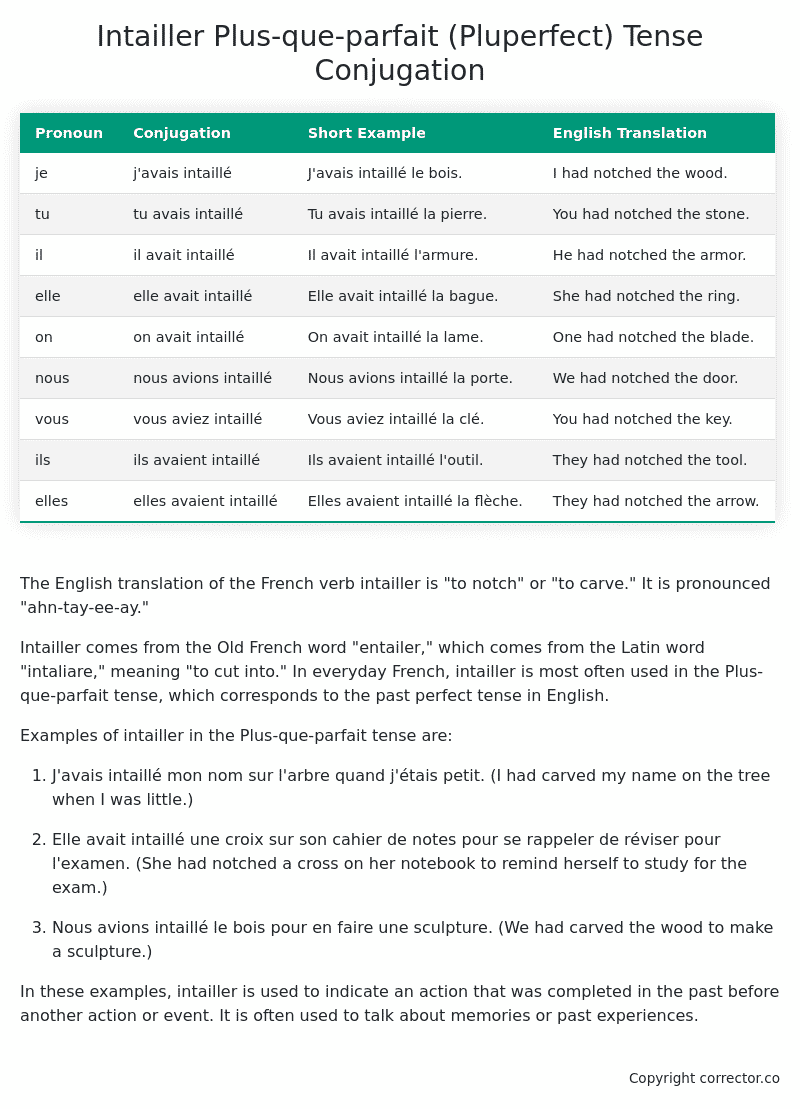Plus-que-parfait (Pluperfect) Tense Conjugation of the French Verb intailler
Introduction to the verb intailler
The English translation of the French verb intailler is “to notch” or “to carve.” It is pronounced “ahn-tay-ee-ay.”
Intailler comes from the Old French word “entailer,” which comes from the Latin word “intaliare,” meaning “to cut into.” In everyday French, intailler is most often used in the Plus-que-parfait tense, which corresponds to the past perfect tense in English.
Examples of intailler in the Plus-que-parfait tense are:
-
J’avais intaillé mon nom sur l’arbre quand j’étais petit. (I had carved my name on the tree when I was little.)
-
Elle avait intaillé une croix sur son cahier de notes pour se rappeler de réviser pour l’examen. (She had notched a cross on her notebook to remind herself to study for the exam.)
-
Nous avions intaillé le bois pour en faire une sculpture. (We had carved the wood to make a sculpture.)
In these examples, intailler is used to indicate an action that was completed in the past before another action or event. It is often used to talk about memories or past experiences.
Table of the Plus-que-parfait (Pluperfect) Tense Conjugation of intailler
| Pronoun | Conjugation | Short Example | English Translation |
|---|---|---|---|
| je | j’avais intaillé | J’avais intaillé le bois. | I had notched the wood. |
| tu | tu avais intaillé | Tu avais intaillé la pierre. | You had notched the stone. |
| il | il avait intaillé | Il avait intaillé l’armure. | He had notched the armor. |
| elle | elle avait intaillé | Elle avait intaillé la bague. | She had notched the ring. |
| on | on avait intaillé | On avait intaillé la lame. | One had notched the blade. |
| nous | nous avions intaillé | Nous avions intaillé la porte. | We had notched the door. |
| vous | vous aviez intaillé | Vous aviez intaillé la clé. | You had notched the key. |
| ils | ils avaient intaillé | Ils avaient intaillé l’outil. | They had notched the tool. |
| elles | elles avaient intaillé | Elles avaient intaillé la flèche. | They had notched the arrow. |
Other Conjugations for Intailler.
Le Present (Present Tense) Conjugation of the French Verb intailler
Imparfait (Imperfect) Tense Conjugation of the French Verb intailler
Passé Simple (Simple Past) Tense Conjugation of the French Verb intailler
Passé Composé (Present Perfect) Tense Conjugation of the French Verb intailler
Futur Simple (Simple Future) Tense Conjugation of the French Verb intailler
Futur Proche (Near Future) Tense Conjugation of the French Verb intailler
Plus-que-parfait (Pluperfect) Tense Conjugation of the French Verb intailler (this article)
Passé Antérieur (Past Anterior) Tense Conjugation of the French Verb intailler
Futur Antérieur (Future Anterior) Tense Conjugation of the French Verb intailler
Subjonctif Présent (Subjunctive Present) Tense Conjugation of the French Verb intailler
Subjonctif Passé (Subjunctive Past) Tense Conjugation of the French Verb intailler
Subjonctif Imparfait (Subjunctive Imperfect) Tense Conjugation of the French Verb intailler
Subjonctif Plus-que-parfait (Subjunctive Pluperfect) Tense Conjugation of the French Verb intailler
Conditionnel Présent (Conditional Present) Tense Conjugation of the French Verb intailler
Conditionnel Passé (Conditional Past) Tense Conjugation of the French Verb intailler
L’impératif Présent (Imperative Present) Tense Conjugation of the French Verb intailler
L’infinitif Présent (Infinitive Present) Tense Conjugation of the French Verb intailler
Struggling with French verbs or the language in general? Why not use our free French Grammar Checker – no registration required!
Get a FREE Download Study Sheet of this Conjugation 🔥
Simply right click the image below, click “save image” and get your free reference for the intailler Plus-que-parfait tense conjugation!

Intailler – About the French Plus-que-parfait (Pluperfect) Tense
Tense Formation
Common everyday usage patterns
Sequencing of past events
Background information
Hypothetical or reported speech
Interactions with other tenses
Summary
I hope you enjoyed this article on the verb intailler. Still in a learning mood? Check out another TOTALLY random French verb conjugation!


